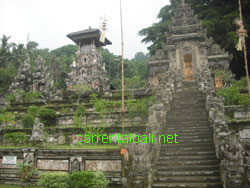Bali Car Rental Blog
Kehen Temple in Bangli Regency Bali
19 August 2011Aside from having strategic location, the entrance of the temple does not apply candi bentar o split gates as found in other temples in general. The entrance gate of Kehen Temple is indeed somewhat different, namely candi kurung or arched entrance. In addition, the existence of Bale Kulkul or pavilion of wooden split bell on the trunk of banyan tree gives different characteristic to Kehen Temple posing one of the leading tourist objects in the city of Bangli Regency.
 This temple is visited by many tourists because of its religious architectural appeals along with spatial layout with the background of verdant hills near the town of Bangli. This temple is categorized into an ancient temple. Then, how is the history on the existence of the temple? According
to Jro Mangku Gede Penyarikan, the Kehen Temple had three inscriptions. Based on the three inscriptions, it could be revealed a little direction about the existence of the temple. The inscriptions had been read by an archaeologist from the Netherlands, namely Dr. P.V. Van Stain Callenfanls. The results of his research have been published in the book entitled Epigraphna in 1926. Those inscriptions were written in Sanskrit and Old Javanese language. In terms of Sanskrit, the Kehen Temple has existed in the ninth century AD. Meanwhile, the inscription written in Old Javanese dated 1204 AD mentioned the name of Senapati Kuturan.
This temple is visited by many tourists because of its religious architectural appeals along with spatial layout with the background of verdant hills near the town of Bangli. This temple is categorized into an ancient temple. Then, how is the history on the existence of the temple? According
to Jro Mangku Gede Penyarikan, the Kehen Temple had three inscriptions. Based on the three inscriptions, it could be revealed a little direction about the existence of the temple. The inscriptions had been read by an archaeologist from the Netherlands, namely Dr. P.V. Van Stain Callenfanls. The results of his research have been published in the book entitled Epigraphna in 1926. Those inscriptions were written in Sanskrit and Old Javanese language. In terms of Sanskrit, the Kehen Temple has existed in the ninth century AD. Meanwhile, the inscription written in Old Javanese dated 1204 AD mentioned the name of Senapati Kuturan.
Although the three inscriptions have been found mentioning the Kehen Temple, it cannot be made sure when the temple was built and what the pedigree related to the name of temple is. Based on the third inscription dated 1204 AD, it is mentioned several temples having a unitary relationship to onne another such as the temple of Hyang Hatu, Hyang Kedaton, Hyang Daha Bangli, Hyang Pande, Hyang Wukir, Hyang Tegal, Hyang Waringin, Hyang Pahumbukan, Hyang Buhitan, Hyang Peken Lor, Hyang Peken Kidul and Hyang Kehen.
The Kehen itself is estimated to originate from the word keren (clay stove) , but when associated with the first Sanskrit inscription —without date— there is mentioned the word Hyang Api, Hyang Karinama, Hyang Tanda and the names of some monks. Comparable opinion was also disclosed by Jro Pasek of Kehen Temple as one of the Dangka priest at the Kehen Temple. He claimed not to know so much about the history of Kehen Temple. Nevertheless, he had heard about the uniqueness or mystical events occurring in the Kehen Temple from his father. Appearance of a snake in the morning of 1960 was believed to be a supernatural one and it occurred when the local people just accomplished their cleanup services in the outermost courtyard of the temple.
In addition, local people strongly believe that a broken branch of banyan tree in the temple gave an indication of catastrophe. It was concluded based on their empirical knowledge through the incidents occurred from generation to generation. Not only that, direction of the broken branch was also believed to signify that disaster will afflict a particular person. For example, when the king of Bangli died, the banyan tree’s branch on the northeast broke. Then, when a priest died, the northwest branch of a banyan tree broke. Meanwhile, if the broken branch is located on southeastern and southwestern, then it was believed there would be calamity befalling the local community.




